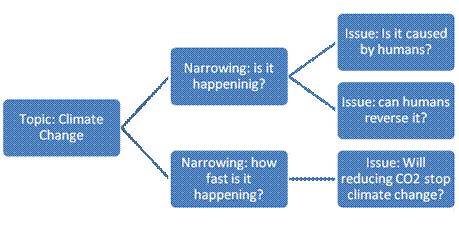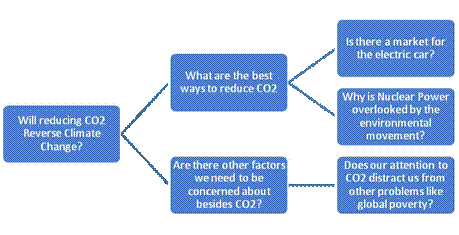Day 17 (Friday, October 2nd)
Lesson Objectives
Students will
Activities
Attendance and introduction (2-3 minutes)
cise (10-15 minutes)Students will have difficulty coming up with an inquiry question. Reviewing the difference between topics and issues will be helpful here. Use the following overhead to review and get students thinking about what topic group they might fall under.
Topics: The following are topics covered in the rhetoric of green inquiry. |
Issues: Within our rhetoric of green inquiry, what is being said—what debates, questions, and frames—within these topics, either in the movie or our other texts. |
Environment and ecoliteracy |
Issues: |
Human thinking and human capacity |
Issues: |
Fresh water |
Issues: |
Oceans |
Issues: |
Air pollution |
Issues: |
Forests and lands |
Issues: |
Species & biodiversity |
Issues: |
Human health |
Issues: |
Environmental justice |
Issues: |
Civil society civilizations collapse |
Issues: |
OIL |
Issues: |
Economy and corporations |
Issues: |
Consumers and media |
Issues: |
Sustainable design |
Issues: |
Renewable energy |
Issues: |
Solutions from nature |
Issues: |
Individual action |
Issues: |
Other topics? |
|
On the board create the following narrowing tree, using the rhetoric of green example or one of your own. Have the students continue to narrow the question until they are asking questions that are specific, narrow, current and debatable.
Topic Narrowing Issues Narrowing Further

Narrowing Further Narrowing Further Inquiry Question

Write-to-Learn (8-10 minutes)
Have students write about their initial ideas for inquiry. They may write in paragraph form or try their hand at their own narrowing tree, like the one above. What are the topics they are thinking of working with for a sustained inquiry? What are the issues within said topic? What inquiry questions can be narrowed from the topic’s issues?
Getting into Groups (15-20 Minutes)
Have students choose their inquiry question and then decide which topic they feel their inquiry question belongs under. Write the topic headings on the board with room to put students’ names and questions alongside the headings.
Topics: The following are topics covered in the rhetoric of green inquiry. |
Inquiry Questions: |
Environment and ecoliteracy |
|
Human thinking and human capacity |
|
Fresh water |
|
Oceans |
|
Air pollution |
|
Forests and lands |
|
Species & biodiversity |
|
Human health |
|
Environmental justice |
|
Civil society civilizations collapse |
|
OIL |
|
Economy and corporations |
|
Consumers and media |
|
Sustainable design |
|
Renewable energy |
|
Solutions from nature |
|
Individual action |
|
Other topics? |
|
You may need to take some liberties in order to ensure a manageable number of groups, and a balanced number of members between groups.
Conclude class and assign homework (3-5 minutes)
Wrap up class as usual, making sure each student has a topic group.
Homework
1) Print out and critically read Assignment 3: Investigating a Research Question and Illustrating your Process of Inquiry (Assignments Tab). Annotate the assignment sheet, marking places where you have questions or concerns. Bring a copy of the assignment, along with your questions to class.
2) Read the following links: AmericanRivers.org. “Cache La Poudre River.” And http://www.gladereservoir.org/
Write a one page summary/response, comparing the values implied in each stakeholder point of view.